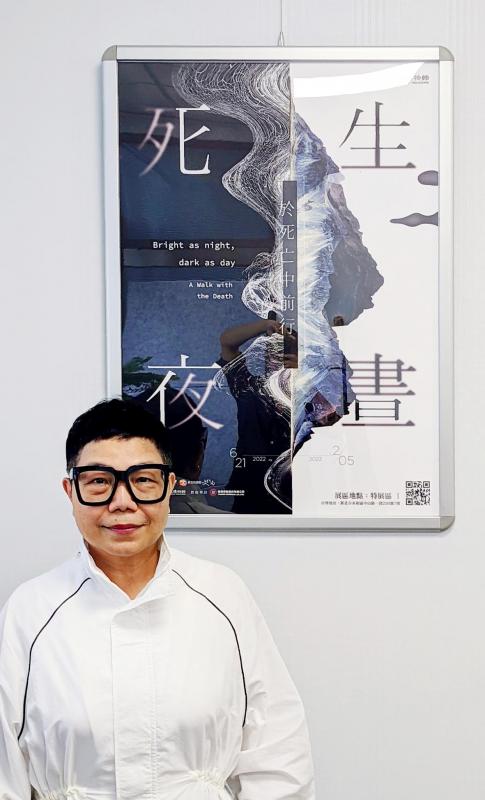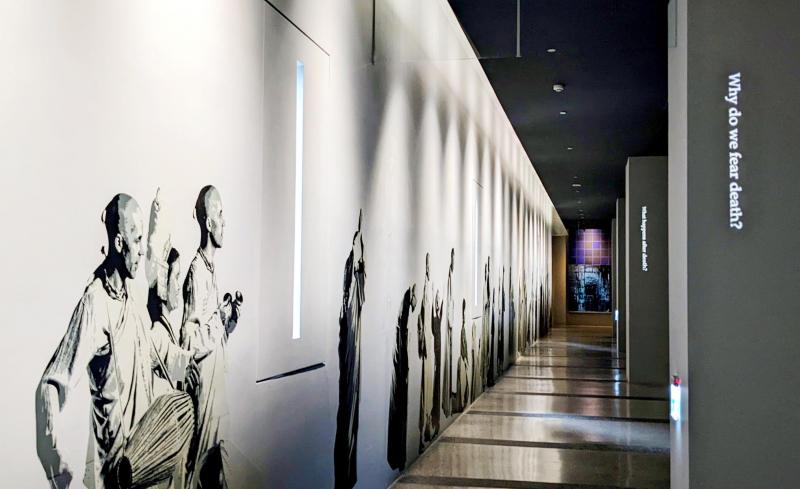The greatest worry Ma Yu-chuan (馬幼娟) has about death is not properly saying farewell to a loved one. And she should know. The practising Muslim recalls that she had a falling out with her father when she was in college. One night he tried to make amends, but she angrily rebuffed him. He died in a car accident the next day.
“Why do we fear death?” is among the many questions posed in the first corridor at the Museum of World Religions (世界宗教博物館) in New Taipei City, where Ma serves as director. There is no correct answer, she says, but after she learned the answer the hard way, she makes sure she’s affectionate to her mother, who suffered a stroke in January.
Since 2019, the museum has put on exhibitions exploring the different stages of human life through various religious concepts and artifacts. So far they’ve covered old age, childhood and marriage. The latest, which opens today, is titled “Bright as Night, Dark as Day, A Walk with the Death” (生死晝夜:於死亡中前行).

Photo: Han Cheung, Taipei Times
“Death is still one of the more taboo topics ... and [museum founder Buddhist Master Hsin Dao (心道)] was concerned that the exhibit might make visitors uncomfortable,” Ma says. “But I don’t think it does. It leaves visitors a lot of space to reflect and contemplate on what death is and why they fear it.”
The exhibition starts with how different religions view death, judgment and the afterlife. But it soon gets personal as visitors enter an empty area for reflection, and then are asked to write down any thoughts they have about life and death, which are displayed on a screen. Finally, they go through an interactive experience of rebirth before they return to everyday life.
Ma says the topic of religion, on its own, is a touchy subject for many people, even though the museum’s aim is to promote mutual understanding of all faiths and reduce the religious strife that has plagued the world since antiquity.

Photo: Han Cheung, Taipei
Hence the emphasis on life-and-death education, which is common to almost all religions and relatable to everybody. The long-term mission of the museum, according to its Web site, is to “enable people to reflect on their inner selves by drawing from the perspectives of life and death of different religions.”
“If we zoom out to a broader perspective, death is just a small part of nature,” Ma says. “Only when you look at it from a human angle does it become such a monumental matter. In Islam, some say that we die every time we fall sleep ... I hope people will think deeply about these differences.”

Sept. 1 to Sept. 7 In 1899, Kozaburo Hirai became the first documented Japanese to wed a Taiwanese under colonial rule. The soldier was partly motivated by the government’s policy of assimilating the Taiwanese population through intermarriage. While his friends and family disapproved and even mocked him, the marriage endured. By 1930, when his story appeared in Tales of Virtuous Deeds in Taiwan, Hirai had settled in his wife’s rural Changhua hometown, farming the land and integrating into local society. Similarly, Aiko Fujii, who married into the prominent Wufeng Lin Family (霧峰林家) in 1927, quickly learned Hoklo (commonly known as Taiwanese) and

The low voter turnout for the referendum on Aug. 23 shows that many Taiwanese are apathetic about nuclear energy, but there are long-term energy stakes involved that the public needs to grasp Taiwan faces an energy trilemma: soaring AI-driven demand, pressure to cut carbon and reliance on fragile fuel imports. But the nuclear referendum on Aug. 23 showed how little this registered with voters, many of whom neither see the long game nor grasp the stakes. Volunteer referendum worker Vivian Chen (陳薇安) put it bluntly: “I’ve seen many people asking what they’re voting for when they arrive to vote. They cast their vote without even doing any research.” Imagine Taiwanese voters invited to a poker table. The bet looked simple — yes or no — yet most never showed. More than two-thirds of those

In the run-up to the referendum on re-opening Pingtung County’s Ma-anshan Nuclear Power Plant last month, the media inundated us with explainers. A favorite factoid of the international media, endlessly recycled, was that Taiwan has no energy reserves for a blockade, thus necessitating re-opening the nuclear plants. As presented by the Chinese-language CommonWealth Magazine, it runs: “According to the US Department of Commerce International Trade Administration, 97.73 percent of Taiwan’s energy is imported, and estimates are that Taiwan has only 11 days of reserves available in the event of a blockade.” This factoid is not an outright lie — that

Former Chinese Nationalist Party (KMT) chairwoman Hung Hsiu-chu’s (洪秀柱) attendance at the Chinese Communist Party’s (CPP) “Chinese People’s War of Resistance Against Japanese Aggression and the World Anti-Fascist War” parade in Beijing is infuriating, embarrassing and insulting to nearly everyone in Taiwan, and Taiwan’s friends and allies. She is also ripping off bandages and pouring salt into old wounds. In the process she managed to tie both the KMT and the Democratic Progressive Party (DPP) into uncomfortable knots. The KMT continues to honor their heroic fighters, who defended China against the invading Japanese Empire, which inflicted unimaginable horrors on the